MOURNE AND RING OF GULLION PUBLIC ART
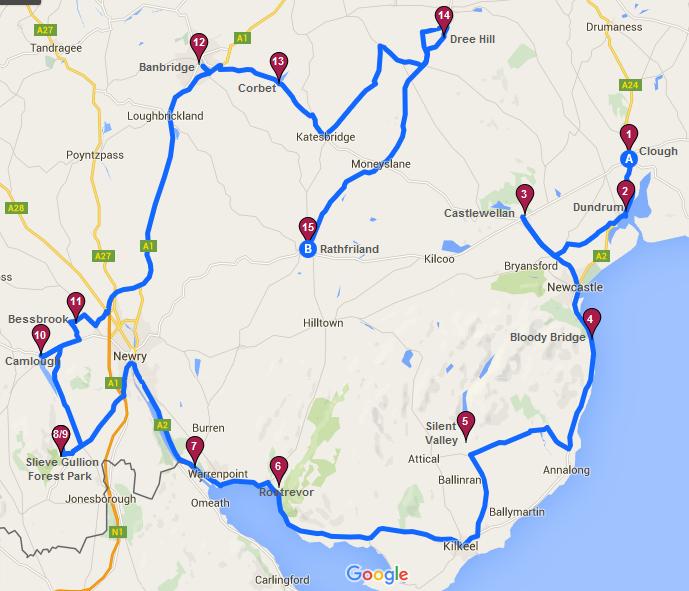
1. ‘On The Way To The Fair’
Clough, Co Down (Roundabout at junction of A7, A24 and A25)
Fairs were held all over Northern Ireland and, as well as trading and creating employment opportunities, they were also a social event. The farmer driving his cattle to the fair was a common sight in Clough and the surrounding area, however this became less common in the late 1940s due to improved roads and a new mode of transport. The use of stainless steel brings a modern twist to this very traditional agricultural scene.
2. ‘Tonn Ruray Sculptural Horn’
Dundrum, Co Down (Main Street Car Park)
The 'Tonn Ruray' is the mythical wave associated with Dundrum. This sculptural horn evokes the forms of ancient cultures, with inspiration taken from the earliest trumpets indigenous to Ireland. The mouth piece becomes a sonic ear piece through which the actual sounds of the bay are concentrated, amplified and can be heard. The horn also has a visual aspect in that it can be used as a scope to frame the image of the bay. Historical text and images relating to the village, supplied by the local community, embellish this interactive piece.
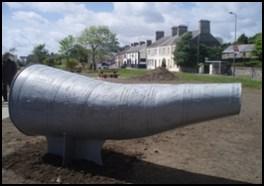
3. ‘Square Days And Fair Days’ Castlewellan, Co Down (Upper Square)
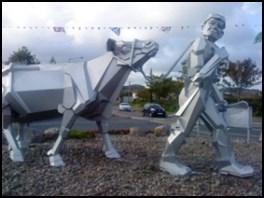
This artwork celebrates the history of Castlewellan as a centre for markets and hiring fairs as well as the town’s strong association with traditional music. It depicts a parade of animals and produce led by a fiddler and a dancing girl “to market to market to buy a fat pig home again, home again, jiggidy jig”. The sow is taken from the famous photograph of the “Old Ulster Pig” in Castlewellan fair.
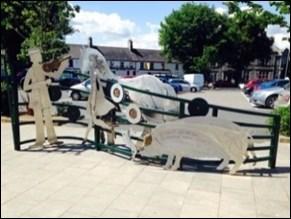 Mourne and Ring of Gullion Public Art
Mourne and Ring of Gullion Public Art
4. ‘The Smuggler’s Head’ Newcastle, Co Down (Bloody Bridge, Ballagh Road)
The sculpture consists of two columns which are similar to the wind and water shaped rocks of the coastal area at the Bloody Bridge. The 'Smuggler’s Head' refers to the age old custom of smuggling, which was synonymous with this part of the coastline. Focus closely on the gap and, from the correct angle, the outline of the smuggler’s head becomes visible. The concept behind the piece is that a smuggler must be almost invisible and that he must almost become part of the landscape, if he is to go un noticed.
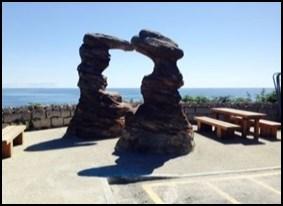
5. ‘The Mourne Hand’ Kilkeel, Co Down (Silent Valley Mountain Park, Head Road)
The inspiration for this piece has come from many sources. The Mourne granite bowl and wedge represent the reservoir and the dam. The Binnian Tunnel is the 7 ft arch the same size as the actual tunnel. The other 'trumpet like' forms announce the diversity of nature to be found around the Silent Valley, while the stalks are tributaries within the water catchment area. The Hand at the base is a reference to the men of Mourne that built the wall, dams and tunnel whose children remember them having “broad shoulders and hands like shovels” men of the land.
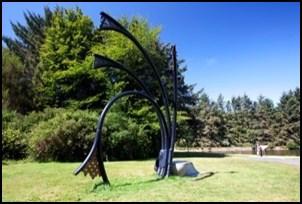
6. ‘The Narnia Trail’ Rostrevor, Co Down (Kilbroney Park)
C.S Lewis wrote in a letter to his brother “That part of Rostrevor which overlooks Carlingford Lough is my idea of Narnia”. Walk through the ‘Wardrobe Door’ and past the ‘Lamp’ into the bewitched and enchanted land of Narnia. The Narnia Trail draws on and encapsulates the inspiration that C.S Lewis found within the Rostrevor area. Features along the trail include 'The Beaver's House', 'The Tree People' as well as ‘The Four Thrones’. This family trail seeks to capture the imagination of children of all ages.
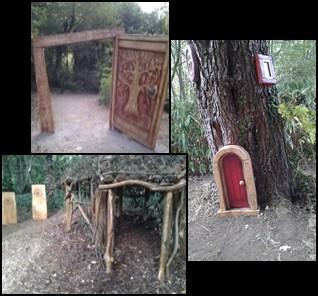 Mourne and Ring of Gullion Public Art
Mourne and Ring of Gullion Public Art
7.
‘The Irish Elk’
Warrenpoint, Co Down (Narrow Water Roundabout, A2 to Newry)
This is a life size (2.1m/6.9ft tall at the shoulders) sculpture of an Irish Elk (or giant deer) . Megalocerosgiganteus had the largest antlers of any known cervid; a max. of 3.65m/12ft from tip to tip and weighing up to 40kgs/88lbs. The size of the antlers is distinctive and several theories have arisen as to their evolution. One theory was that their antlers increased in size because males used them in combat for females; it was also suggested that they became so unwieldy that the Irish Elk could not carry on the normal business of life and so became extinct. For the passing viewer, it is a reminder of evolution, time and a reminder of an age when the wilderness of the land dominated the environment.
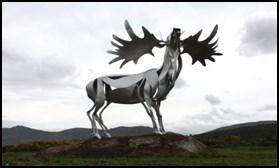
8
‘The Calliagh Beara’
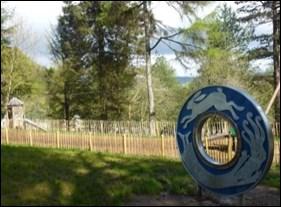
Meigh, Co Armagh (Slieve Gullion Forest Park)
This art feature follows the footsteps of the legendary Fionn MacCumhaill (or Finn McCool), of the Fianna warriors. Fionn walked up the slopes of Slieve Gullion to the lake near the summit to find a beautiful young lady sobbing on the water's edge. Being a gentleman he enquired as to why she was crying, to which she replied that she had dropped her golden ring in the bottomless lake. Without a moment's hesitation, Fionn ripped off his shirt and dived in, swam down until he found the ring, grabbed it and returned to the top only to find an old hag (the Calliagh Berra) laughing. The witch had tricked Fionn and he crawled out on the lake's shore as an old, withered man. Fionn came down the mountain unrecognisable even to the Fianna ! However, when his trustworthy Irish Hound smelled the old man, he knew that he was their master. Fionn, the Fianna and the hounds forced the Calliagh Berra to restore Fionn to his youth, but it is said that his hair remained white, like an old man's, for the rest of his life, and that this fate will befall anyone who bathes in the lake to this very day.
Mourne and Ring of Gullion Public Art
9. ‘The Giant’s Lair’
Meigh, Co Armagh (Slieve Gullion Forest Park)
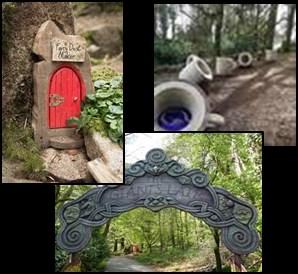
Children’s laughter echoes round Slieve Gullion Forest Park as they make their way around the Giant’s Lair past tiny, sculptural fairy gardens, through giant willow tunnels and over hanging villages of tree houses. The images shown are only a few of the many pieces of artwork included in The Giant's Lair. The Giant's Lair follows a trail, approximately 1 mile long, through the woodland. It is an innovative, magical, living storybook which takes visitors (adults, children, elves and fairies) on an unforgettable journey creating a fantastical childhood land of mystery, dragons, giants, witches and fairies. The Giant's Lair is inspired by the rich tapestry of local legend and mythical folklore of the woodlands at Slieve Gullion.
10. ‘In Flux’
Camlough, Co Armagh (At junction of A25 and Newtown Road)
The geometric 4m high piece of artwork expresses the dynamic energy and complexity of the natural water cycle, from cloud to the area’s great ‘Crooked Lake’, from river to mill pond and its eventual evaporation. The concept was taken from a childrens’ drawing at a community engagement workshop. The work uses a spectacular visual effect, created by shaping and layering stainless steel mesh into the form of an evolving cloud that represents the water cycle. Placed within a rectangular mesh container, it is mounted on a stainless steel base on which are engraved lines of Richardson’s Ballad of Camlough. The upper surface of the base is forged into rippled water texture. For passing traffic, the mesh creates a moiré effect of the cloud during daytime while internal lighting creates spectacular illuminations of the cloud at night.
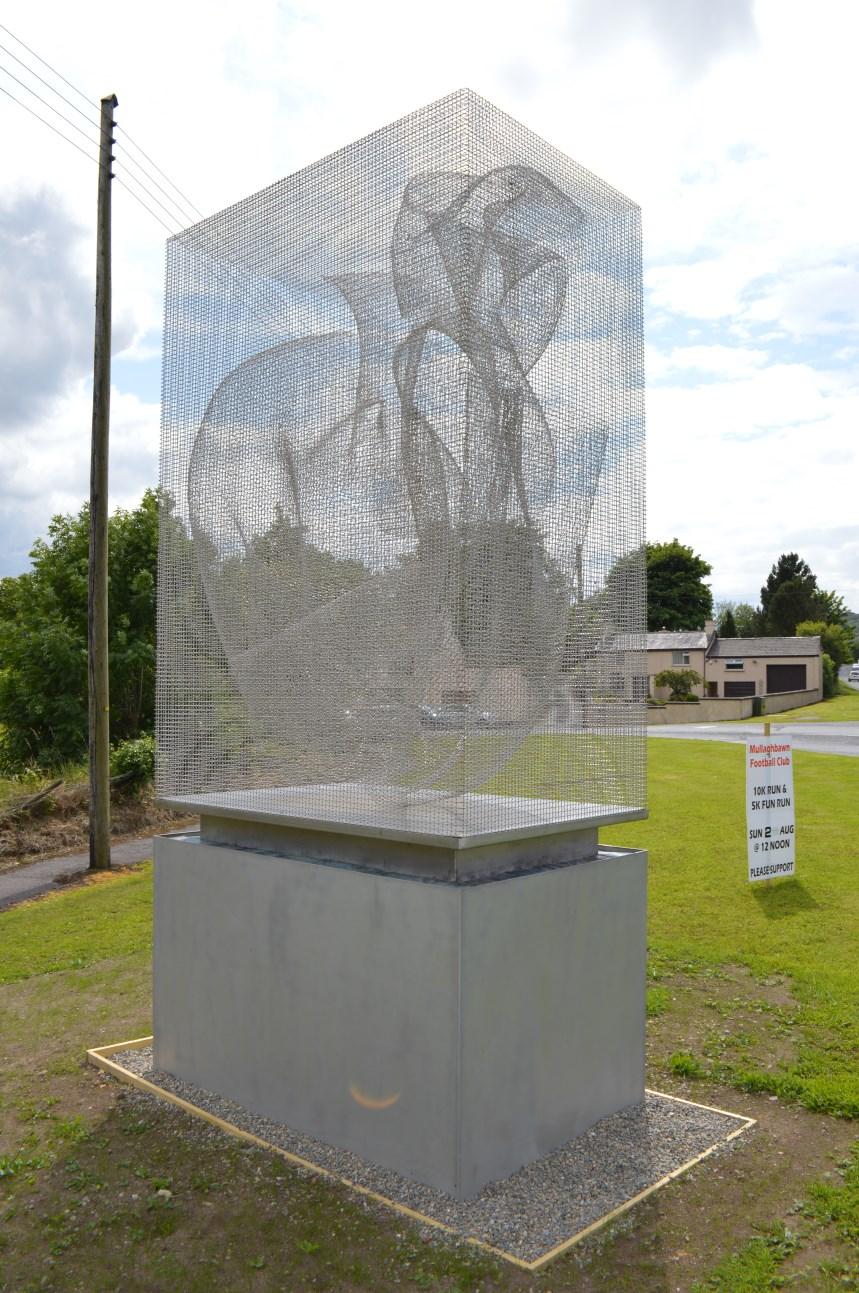 Mourne and Ring of Gullion Public Art
Mourne and Ring of Gullion Public Art
11. ‘The Flax Flower’ Bessbrook Pond, Co Armagh
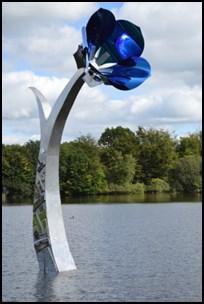
Glimpses of the tranquil millpond in Bessbrook village are lit by the electric blue and silver of the statuesque flax flower, telling the story of the linen industry in the area. “Know ye the fame of the brilliant little river, Which floweth through Bessbrook from moorland and lea, Between blue waving flax flowers and rushes which quiver, He runs his short course from the lake to the sea.” This opening verse of “The Ballad of Camlough River”, by James N Richardson is the inspiration for this sculpture. The verse sets the scene of the origins of Camlough River, which flows from Camlough Lake and is harnessed at Bessbrook pond to power the Bessbrook mill, which in turn drove the local economy, forging communities and a social scene that survives to this day. Key to this industry, is the flax plant. Without it, the river may have ran its course to the sea. The production, processing and eventual weaving of the plant's fibre is why the river rose to fame and the local area became a centre for the linen industry.
12. ‘From The Bridge To The Hills’ Banbridge, Co Down (Kenlis Street)
This piece of artwork is a stylised representation of the route of the River Bann, from Banbridge to the river’s source at Slieve Muck (Pig Mountain) in the heart of the Mourne Mountains. The artwork creates a visual link between the busy market town and the hills beyond to the South and, as such, signifies Banbridge as a gateway to the Mournes. The bronze flax flowers on the floorscape represent the linen industry which was prevalent in the Banbridge area.
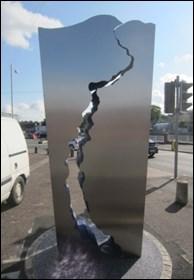 Mourne and Ring of Gullion Public Art
Mourne and Ring of Gullion Public Art
13. ‘Spins The Reel, Spins the Wheel’
Corbet Co Down (Corbet Lough, Castlewellan Road A50)
This piece focuses on the industrial and cultural heritage of the linen industry. Corbet Lough was created to aid the process of linen production in 1836 by the Bann Reservoir Company. The seated area is constructed from Mourne Grey Granite with a series of bronze tiles that have angler’s knots, cast from flax fibre, and rope, created through a series of community workshops. The Portland Stone Column is constructed from 7 circular wheel shaped mill stones. Each stone has an oval section removed to visually create a twisting and reeling motion. The 7 oval segments that have been removed are arranged on top of the column to crown the sculpture, suggesting leaping fish or a growing flax head. The flax seed plant appears at the top of the structure, while waves ripple and weave their way up the inner section of the column. The engraved text refers to the processes involved in linen production.

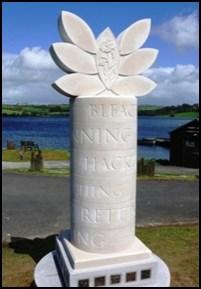
14. ‘Blaeberry Sunday’ Finnis, Co Down (Peter Morgan’s Cottage)
Focusing on the annual 'Blaeberry Sunday' walk to the summit of Slieve Croob, the stone 'bas relief' is circular and is compared to the 'Blue Heritage Plaques' associated with famous people and buildings by the Historic Buildings and Monuments Commission. The references within the imagery play heavily on 'marking the end of summer growth and the beginning of autumn harvest'. Spread out upon a table is a large 'Celtic inscribed pot and plate containing the fruits of the forest'. Also depicted are images of the local landscape, featuring examples of 'famine fields' or 'lazy beds'. The Mournes are peppered with various stone walls and terrains whose textures are found throughout the stone carving, suggesting and referencing the viewer to the very depth of the geology that they will encounter on this auspicious walk. The poem on the plaque is titled 'Blaeberry Sunday' which was written by Mr Pat King.
15. ‘The Luck Penny’ Rathfriland, Co Down (Market Square)
The theme of this artwork is derived from the town’s connection with markets and, specifically, the practice of giving back a penny for luck once a deal had been sealed. Rathfriland’s markets took place on different days for different produce as well as farm animals such as sheep, goats and donkeys, flax and linen were also bought and sold (the Market House was originally built to trade linen). Images of the wide range of produce associated with the markets are etched into the surface, with a large bronze “Luck Penny” forming the centre piece. Interestingly, the site of the sculpture was once the site of the public toilets so the concept of “spending a penny” is somewhat appropriate too !
 Mourne and Ring of Gullion Public Art
Mourne and Ring of Gullion Public Art
Thanks to all our funders:



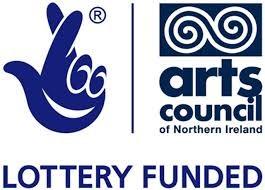
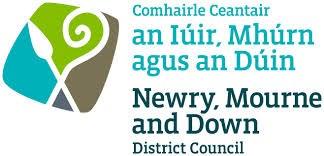






Mourne Heritage Trust Unit 3 Cornmill Quay Annalong Marine Park Annalong Co Down BT34 4QG


Tel: 028 4372 4059 Email: mht@mourne.co.uk W: www.mournelive.co.uk
Ring of Gullion AONB Crossmaglen Community Centre O’Fiach Square Crossmaglen Co Armagh BT35 9AA
Tel: 028 3086 1949 Email: info@ringofgullion.org W: www.ringofgullion.org
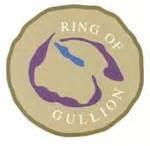











 Mourne and Ring of Gullion Public Art
Mourne and Ring of Gullion Public Art
 Mourne and Ring of Gullion Public Art
Mourne and Ring of Gullion Public Art


 Mourne and Ring of Gullion Public Art
Mourne and Ring of Gullion Public Art
 Mourne and Ring of Gullion Public Art
Mourne and Ring of Gullion Public Art










